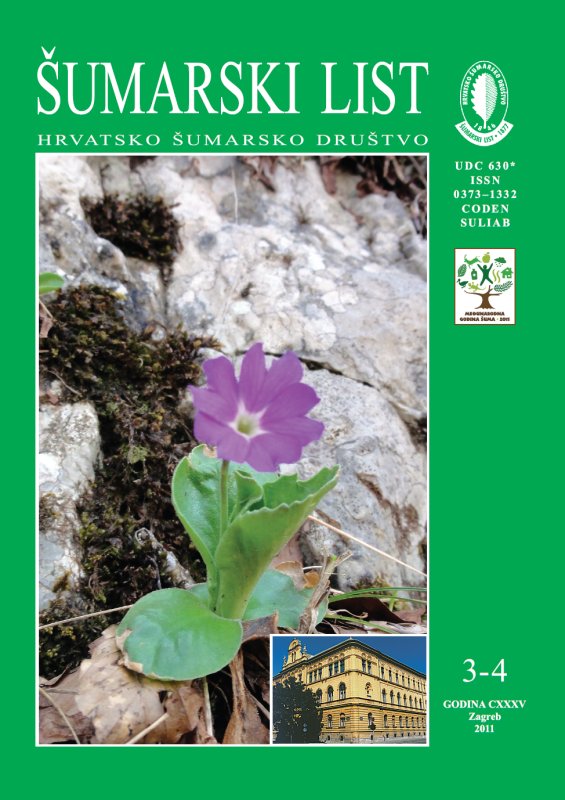
broj: 3-4/2011
pdf (7,98 MB) |
|
||||||||||||||
| RIJEČ UREDNIŠTVA | ||
| Uredništvo | ||
| SOMETHINGABOUT THE CLASSICAL COMMERCIAL VALUE OF FORESTS pdf HR EN | 97 | |
| IZVORNI ZNANSTVENI ČLANCI | ||
| Ugarković, D., I. Tikvić, Z. Seletković, M. Oršanić, I. Seletković, M. Blažinkov, M. Mrkonjić Fuka, S. Redžepović | UDK 630* 114.2 + 231 (Abies alba Mill.) (001) | |
| Microbiological Characteristics of the Soils and Natural Regeneration of Forest Gaps within Damaged Forest Ecosystems of the Silver Fir (Abies alba Mill.) in Gorski Kotar pdf HR EN | 99 | |
| Kutnar, L., A. Kobler | UDK 630* 188 + 111.8 (001) | |
| Prediction of Forest Vegetation Shift due to Different Climate-Change Scenarios in Slovenia pdf HR EN | 113 | |
| Abstract: By using an empirical GIS model, the potential spatial changes of forest vegetation driven by expected climate change have been analysed. Based on the three different scenarios predicting climate warming in Slovenia (the mean, pessimistic and optimistic scenarios), the simulation showed that the share of vegetation types will be altered under the impacts of climate change, and the shift of vegetation belts upwards might be expected. By the year 2100, the share of mesic beech forests is likely to decrease. From ecological, – nature-conservation – and forest-management points of view, the predicted decrease of the share of Dinaric fir-beech forests is especially important. The model predicts an increase of the share of thermophilous forests from the present 14% to a range between 50% (according to the optimistic scenario) and 87% (according to the pessimistic scenario). A significant part of the coniferous forest with Picea abiesand Abies alba predominating might be converted to deciduous forests. Key words: climate change; climate scenarios; forest vegetation; model; simulation | ||
| Buzjak, N., S. Buzjak, D. Orešić | UDK 630* 111 +120 : 164 (001) | |
| Floristic, Microclimatic and Geomorphological Features of Collapsed Doline Japage on the Žumberak (Croatia) pdf HR EN | 127 | |
| Sedlar, Z., V. Hršak, R. Šoštarić | UDK 630* 187 (001) | |
| Numerical and PhytosociologicalAnalysis of the Junipero sibiricae -Pinetum dalmaticae Domac (1956) 1965 Association and Comparison to Mediterranean Forests Dominated by Pinus nigra Arn. s.l. pdf HR EN | 139 | |
| STRUČNI ČLANCI | ||
| Nodilo, Marija | UDK 630* 272 | |
| Garden of the Benedictine Monastery of St Mary on Mljet pdf HR EN | 153 | |
| Puača, B., Ž. Najvirt, A. Miličević | UDK 630* 188 + 114 | |
| Some Pedological-floristic and Economic Features of Forest Stands in Locality Otmanov Vis pdf HR EN | 161 | |


